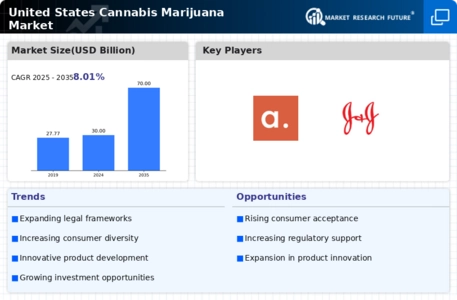Regulatory Changes
The evolving regulatory landscape in the Global United States Cannabis Marijuana Market Industry plays a pivotal role in shaping market dynamics. As more states legalize cannabis for both medicinal and recreational use, the market is projected to reach 30 USD Billion in 2024. This shift not only enhances accessibility for consumers but also encourages investment in the sector. For instance, states like California and Colorado have seen substantial tax revenues from cannabis sales, which further incentivizes other states to consider legalization. The regulatory framework is likely to continue evolving, potentially leading to a more standardized national approach.
Market Growth Chart
Medical Cannabis Demand
The rising demand for medical cannabis is a significant factor propelling the Global United States Cannabis Marijuana Market Industry. With an increasing number of states recognizing the therapeutic benefits of cannabis, patients are turning to these products for relief from conditions such as epilepsy, multiple sclerosis, and chronic pain. This trend is reflected in the growing number of medical cannabis dispensaries across the country. As the medical cannabis segment expands, it is anticipated that the market will reach 30 USD Billion by 2024, underscoring the importance of this sector in the overall market landscape.
Diverse Product Offerings
The diversification of product offerings within the Global United States Cannabis Marijuana Market Industry is a key driver of growth. Companies are increasingly introducing a wide range of cannabis-infused products, including edibles, beverages, and topicals, catering to varying consumer preferences. This variety not only attracts new customers but also encourages existing consumers to explore different consumption methods. As a result, the market is expected to experience a compound annual growth rate of 8.01% from 2025 to 2035. The introduction of innovative products enhances market competitiveness and positions companies to capitalize on emerging trends.
Technological Advancements
Technological advancements in cultivation and processing techniques are transforming the Global United States Cannabis Marijuana Market Industry. Innovations such as hydroponics and advanced extraction methods enhance product quality and yield, allowing producers to meet increasing consumer demand efficiently. These advancements not only improve the economic viability of cannabis production but also contribute to sustainability efforts within the industry. As technology continues to evolve, it is likely to play a crucial role in shaping market dynamics, potentially leading to a market valuation of 70 USD Billion by 2035.
Increasing Consumer Acceptance
Growing consumer acceptance of cannabis products significantly influences the Global United States Cannabis Marijuana Market Industry. As societal perceptions shift, more individuals are exploring cannabis for both recreational and therapeutic purposes. This trend is evidenced by a rise in cannabis consumption among various demographics, including older adults seeking relief from chronic pain. The market's expansion is further supported by educational campaigns that highlight the benefits of cannabis, contributing to a projected market value of 70 USD Billion by 2035. This acceptance is crucial for driving demand and fostering a robust market environment.












